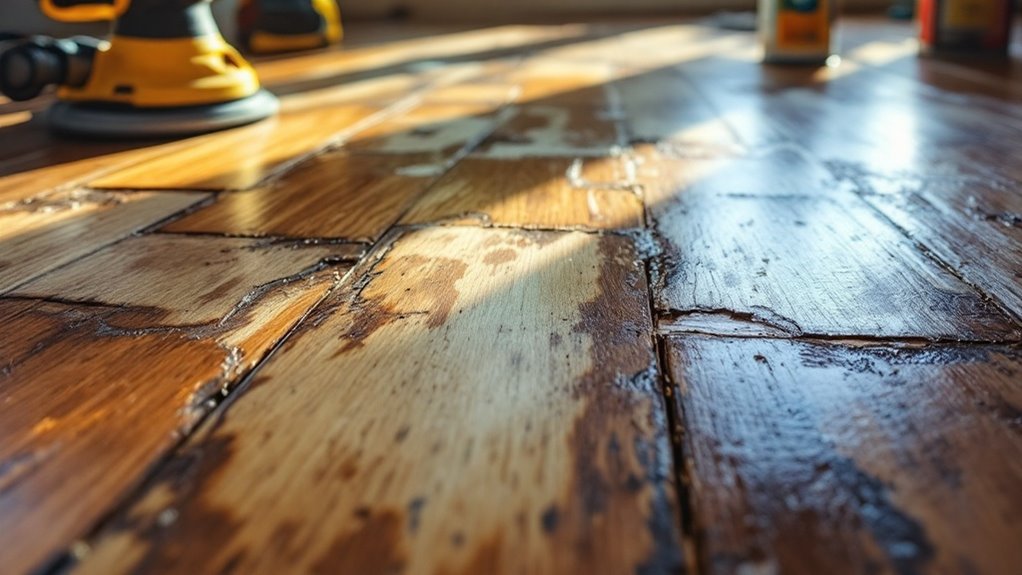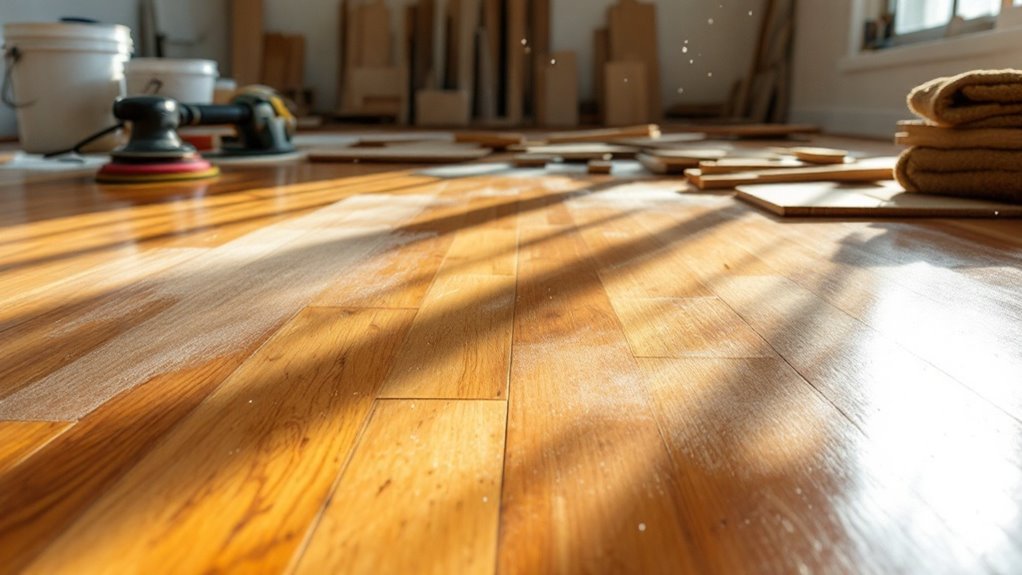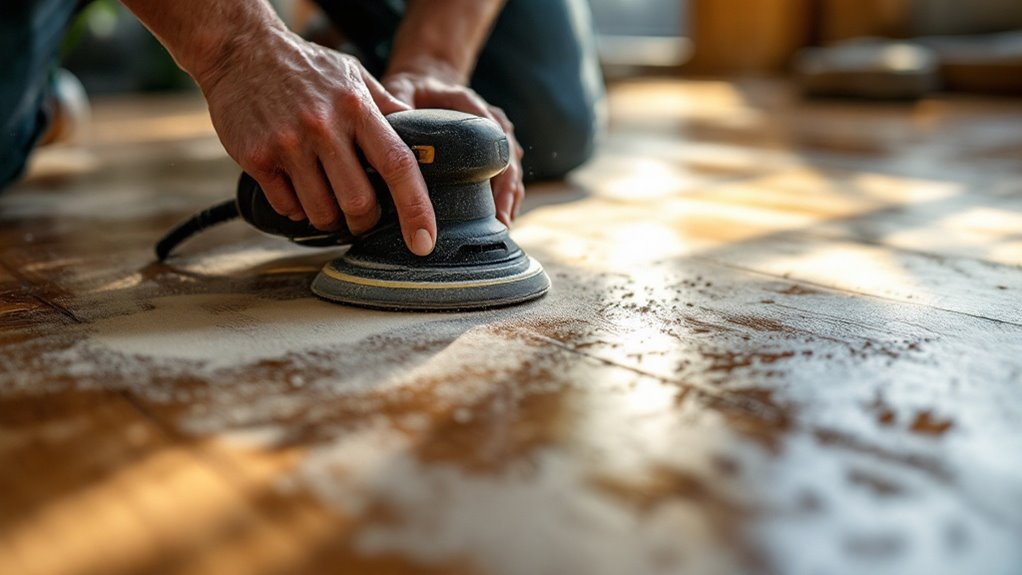You might think that replacing water-damaged hardwood floors is the only option, but restoration can often save you time and money. It’s crucial to assess the damage and consider the unique character of your wood. Understanding the restoration process and weighing the benefits against replacement can lead to a more educated choice. Curious about how this process can improve both your home’s value and sustainability? Let’s investigate the details.
Key Takeaways
- Restoring hardwood floors can be cost-effective, often cheaper than full replacement if addressed promptly.
- Professional restoration ensures quality and faster results compared to DIY methods.
- Preservation of unique hardwood character adds value to your home while minimizing waste.
- Assessing moisture levels and extent of damage is crucial for determining restoration feasibility.
- Immediate action can prevent further damage, saving on more extensive repairs down the line.
Understanding Water Damage and Its Effects on Hardwood Floors

When water seeps into hardwood floors, it can cause significant damage that you might not notice right away. The moisture can weaken the wood, leading to warping, buckling, and even mold growth if not addressed quickly. As water sits, it penetrates deeper, damaging the finish and possibly the subfloor beneath. You may see discoloration, swelling, or even cracks forming, which indicate that the wood’s integrity is compromised. It’s vital to act fast; the longer you wait, the more costly the repairs could become. Understanding these effects helps you recognize the importance of immediate action to preserve your hardwood floors. Addressing the issue promptly can save you time, effort, and money in the long run. Additionally, seeking professional water damage restoration services can provide the necessary expertise to mitigate further damage effectively.
Assessing the Extent of Water Damage
Before you start repairs, it’s essential to assess the extent of water damage to your hardwood floors. Begin by inspecting the surface for any visible signs like discoloration, warping, or buckling. These indicators often mean the damage is more severe than it appears. Next, check for moisture by using a moisture meter; a reading above 12% usually signals significant issues. Don’t forget to look underneath the floors, as lingering moisture can lead to mold growth. If you notice soft spots or a musty smell, it’s a clear sign of deeper damage. Evaluating these factors will help you decide whether repairs are feasible or if replacement is necessary. Taking the time to assess now can save you headaches later. Additionally, ignoring early signs of water damage can lead to severe consequences, including extensive and costly repairs.
The Restoration Process: Steps to Take

Once you’ve assessed the extent of the water damage, it’s time to plunge into the restoration process. Begin by removing any standing water with a wet vacuum or mop, ensuring the area is as dry as possible. Next, increase airflow by opening windows and using fans to promote drying. If the wood has buckled or warped, consider using a moisture meter to gauge humidity levels before proceeding. After the wood dries, sand down any rough spots to create a smooth surface. You may likewise need to apply a wood conditioner to help the finish adhere better. Finally, choose a suitable sealant or finish to protect your floors and restore their beauty. This careful approach can make a significant difference in the outcome. Additionally, ensure you monitor humidity levels with hygrometers and moisture detectors to prevent mold growth during the drying process.
DIY vs. Professional Restoration
How do you decide between tackling hardwood floor restoration yourself or hiring a professional? It often comes down to your skills, time, and the extent of the damage. A DIY approach can be rewarding, but it requires tools and knowledge. On the other hand, professionals bring expertise and can spot hidden issues you might miss.
| DIY Restoration | Professional Restoration | Considerations |
|---|---|---|
| Cost-effective | Higher initial costs | Budget |
| Time-consuming | Quicker turnaround | Urgency |
| Requires skill | Expertise guarantees quality | Quality assurance |
| Satisfaction of DIY | Professional peace of mind | Confidence in results |
| Learning experience | Less stress | Personal capability |
Ultimately, weigh your options carefully to choose the best path for your situation.
Costs Involved in Restoring Hardwood Floors

Choosing between DIY and professional restoration often leads to questions about costs, which can vary widely based on several factors. If you decide to go the DIY route, you’ll need to assess the price of materials, tools, and potential rental equipment, which could range from a few hundred to over a thousand dollars. On the other hand, hiring professionals typically incurs labor costs that can range from $3 to $8 per square foot, depending on the extent of the damage and your location. Additional expenses may include moisture testing and refinishing services. Ultimately, evaluating your budget and skill level will help you determine the most cost-effective approach for restoring your hardwood floors after water damage.
Benefits of Restoring vs. Replacing Floors
While it may be tempting to replace water-damaged hardwood floors entirely, restoring them often offers significant advantages that shouldn’t be overlooked. First, restoration is typically more cost-effective than replacement, allowing you to save money while still achieving a beautiful finish. Moreover, restoring your floors can preserve their unique character and history, something new floors often lack. You’ll likewise minimize waste, making it an environmentally friendly choice. Plus, restoration can often be done quickly, reducing disruption to your home. By opting to restore, you maintain the integrity of your space while enhancing its value. Ultimately, you’ll enjoy stunning floors that tell a story, all while being kinder to your budget and the planet.
Preventative Measures for Future Water Damage
Restoring your hardwood floors is a great way to preserve their character, but taking steps to prevent future water damage is just as important. Start by checking for leaks in plumbing and appliances; a small drip can lead to significant damage over time. Consider using area rugs in high-risk spots, like entryways and kitchens, to absorb excess moisture. Invest in a dehumidifier, especially in humid climates, to keep your indoor air dry. Furthermore, maintain your home’s gutters and downspouts to direct water away from your foundation. Finally, be mindful of spills—clean them up immediately to prevent seepage. By taking these preventative measures, you’ll help guarantee your hardwood floors stay beautiful and protected for years to come.
Making the Decision: Restore or Replace?
How do you decide whether to restore or replace your hardwood floors after water damage? Start by evaluating the extent of the damage. Consider these three factors:
- Severity: If your floors are warped or severely stained, replacement may be the better option.
- Cost: Calculate the cost of restoration versus replacement. Sometimes, replacing with new materials can be more economical in the long run.
- Sentimental Value: If the floors have historical significance or emotional ties, restoration might be worth the investment.
Ultimately, weigh the pros and cons of each choice. Think about your budget, the condition of your existing floors, and how long you plan to stay in your home. This will guide you to a decision that suits your needs.
Conclusion
Deciding whether to restore or replace your hardwood floors after water damage can feel like choosing between saving a cherished heirloom or buying a new piece of furniture. Just as a well-loved item carries memories and character, your floors hold the stories of your home. By opting for restoration, you’re not just reviving wood; you’re preserving the heart of your space. So weigh your options carefully—sometimes, the best choice is to breathe new life into what you already have.
